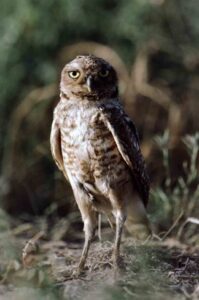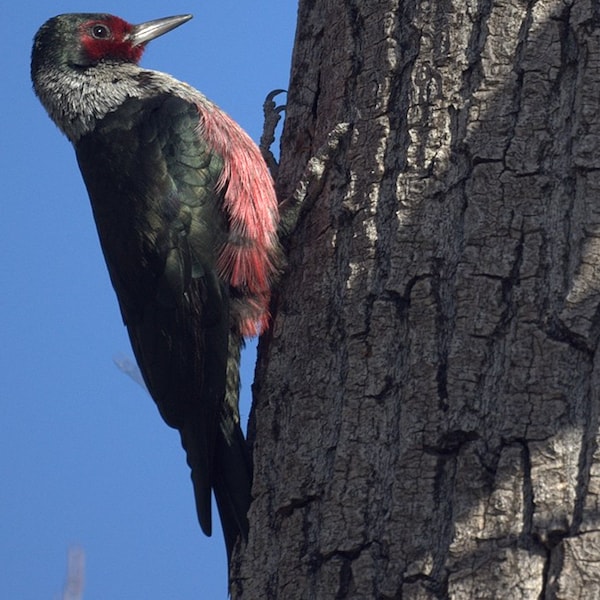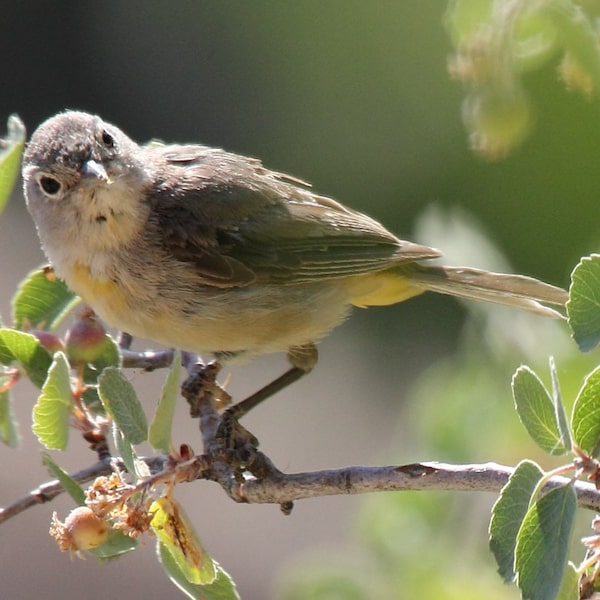Several sets of binoculars were fixed on the bright yellow eyes of a burrowing owl peering over a mound of dirt that marked his burrow. The owl likely viewed us as potential adversaries, but probably not as it would a coyote, a hawk, or a great horned owl. Instead of worrying too much about us, it occasionally turned its head and focused on a nearby mouse. Strange, to the owl, was the fact that the mouse was pure white, and, further piquing its curiosity, the mouse was apparently not afraid or making any attempt to distance itself from the feathered predator.
Momentarily, the temptation overcame the owl and it “flipped into the air” and made a grab at its quarry. Much to the owl’s surprise, its feet became entangled in an invisible web. Soon, we made our way to the captured owl, secured it, and carefully slipped its talons from the nooses of fishing line that converted a caged mouse into an effective trap.
That was in spring 2003, and this capture marked the beginning of several years of our research on the subspecies. Over the next four years, we studied the ecology of the western burrowing owl, whose scientific name, Athene cunicularia hypugaea, literally means “wise one who dwells under the earth.”

Oddly enough, our focus was on one of the most unlikely of places—the primary facility for maintenance and disassembly of the nation’s nuclear weapons arsenal. The Pantex Plant, a facility within the U.S. Department of Energy/National Nuclear Security Administration complex, encompasses an area of more than 18,000 acres. The operational area of the plant is surrounded by native shortgrass prairie, prairie-dog colonies, playas, cultivated fields, and grasslands enrolled in the Conservation Reserve Program: a landscape representative of the southern High Plains, making it a desirable research site. Other study sites were located farther south in the southern High Plains, involving prairie-dog colonies on the outskirts of Lubbock.
Western burrowing owls breed from southwestern Canada through the Great Plains into the Texas Panhandle. Like most birds, they are migratory and leave northern breeding grounds to overwinter in the southwestern United States, along the Texas Gulf Coast, and down into Mexico. Consequently, Texans may see burrowing owls in different parts of our state throughout the year.
Burrowing owls are among the most conspicuous owls in the United States because they are active during the day, utilize flat terrain and short cover, and often live near human settlements. These traits are at odds with the typically secretive, nocturnal habits of other owl species. Indeed, Texans that pass by or frequent prairie dog colonies may see burrowing owls on a daily basis throughout much of the year and yet never see another type of owl in their entire lives. Others may be unaware of the existence of owls, including burrowing owls that may be quite near them.
The U. S. Fish and Wildlife Service considers the western burrowing owl to be a species of regional conservation priority, and it is a species of international concern. Although Breeding Bird Survey data suggest summer burrowing owl populations have remained stable since those data began being collected in the 1960s, Christmas Bird Counts in the Panhandle indicate a long-term decline in wintering owls since the 1940s. Land conversion to agricultural crops and urban sprawl has played a major role in the decline of prairie-dog colonies and, thus, in burrowing owl populations. The owls do not dig their own burrows; they rely on holes dug by other species such as prairie dogs and badgers. Today, concern for the species persists due to wide-scale use of pesticides to control prairie dogs. This results in the loss of burrows and short cover as nesting habitat, if not direct or secondary poisoning of the owls.
Texas Tech University graduate students Andrew Teaschner (2003-2004) and Erica Chipman (2004-2005) led our research, working on separate study objectives. We assessed abundance, nest-site selection, and productivity; determined whether our wintering owls were residents or migrants; and used radio-telemetry to monitor their movements and behaviors. We also examined whether radio-telemetry necklaces had any negative effects on burrowing owls, which was an important question for this and future research on this species.
One of the difficulties inherent to studying burrowing owls is that individuals look alike. However, there is a way to identify individuals: Give them an ID card in the form of a leg band with a unique number. To increase the ability to identify our individuals, we also placed a color band on the other leg, and these contained an even a larger set of unique numbers to increase readability when viewed through a spotting scope.
Our graduate students would eventually capture and band 137 adults and 16 juvenile burrowing owls. Upon capture, owls were fitted with an U.S. Geological Survey-issued leg band and a color band, and some were equipped with a radio transmitter. An experienced trapping team can work quickly and almost silently, in order to keep stress on the bird to a minimum. Traps had to be monitored at all times to remove the owl as quickly after capture as possible and minimize trap-related stress or injury. This made owl trapping a labor- and time-intensive endeavor. Trapping, banding, and radio marking require permits from the federal and state governments, and universities must follow their own animal care and use guidelines.

Although banding studies provide invaluable information, they provide data only at limited times—the researchers know when and where the bird was banded and where it was sighted after that. At other times, the location of the animal is unknown. Use of radio-telemetry, however, allows information to be gathered continuously (or at least at more times), because the animal can be relocated. The scientist has a radio-signal receiver, and each bird with a transmitter has its own unique radio frequency. By aiming an antenna attached to the receiver in different directions and listening to the clarity and loudness of the “chirps” emitted by the transmitter, the biologist can determine the location of the animal.
Like a person fiddling with a new ring or necklace, our owls took a few days to get used to their new jewelry, including their radio necklace. None of our marked owls were lost to predation during our study, despite the initial distraction of picking at their necklace and bands instead of scanning for predators.
From our banding and radio-telemetry studies, we learned that most of our owls did not overwinter in Texas. One owl overwintered in Mexico, but it is unknown where the others went. Owl behaviors varied with time of day, weather, and the number of chicks being raised by a pair. How an owl spent its time was not affected by whether its prairie-dog colony was surrounded by urbanization or more rural forms of land use, although its diet did: Urban owls tended to eat more aerial insects, whereas more rural owls consumed vertebrate prey such as mice, lizards, and small birds.
We found that the larger a prairie dog colony was and—even more so—the greater the number of burrows, the more pairs of burrowing owls were attracted. No other variable examined contributed to determining the number of owls or how productive they were. Still, we believe that—along with burrows—high visibility produced by the digging, clipping, and grazing activity of prairie dogs is important for the owls’ nesting habitat. We found about three pairs of burrowing owls per acre on our study sites, and each pair raised a brood of about three chicks.
The association of burrowing owls with prairie dog colonies places the species in an unintentional conflict with humans. This is true whether the colony is located in a remote agricultural area or in an area of urban development. Colonies will continue to be at risk of control with rodenticides, affecting the owls through loss of habitat and, possibly, direct mortality. This and other mortality from vehicular collisions, depredation from pets, illegal shooting, and effects of toxic chemicals have led to such worrisome declines that burrowing owls are listed as endangered in Canada, threatened in Mexico, and as a species of special concern throughout the United States.
Wise and considered stewardship will allow us to continue the necessary pursuits of agriculture and urbanization while still delighting in the company of such an endearing bird. We hope that our grandchildren will not learn about burrowing owls in the same breath as the dodo or Carolina parakeet. Rather, we hope that we can generate interest in and inspire affection for a species that is yet within our grasp to hold back from the brink of extinction.




